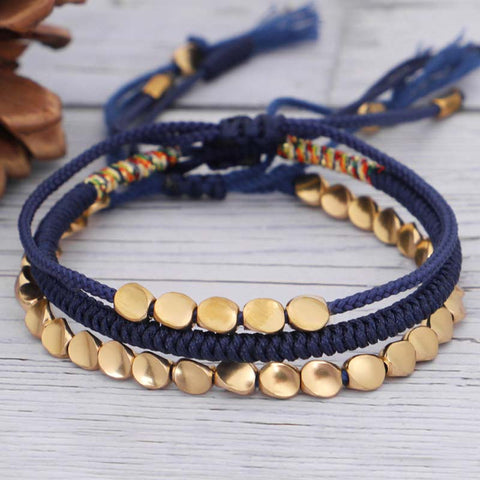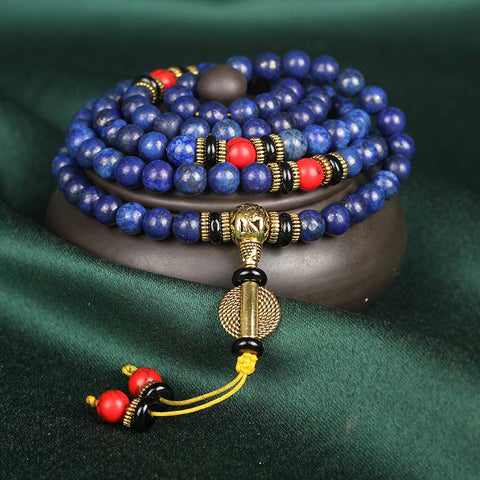Tibetan Jewelry : A Gateway to Timeless Culture
This passage will guide you at:
- What is Tibetan Jewelry?
- Culture and Creativity of Tibetan Jewelry
- Buddha Stones: Preserving Tradition in the Modern Age
- Commitment to Ethical Craftsmanship
- The Art of Tibetan Jewelry
- The Buddha Stones Journey: Embrace the Spirit of Adventure
- Invitation to a Cultural Journey
Text Leading
What is Tibetan Jewelry?
Tibetan jewelry is a vibrant reflection of the culture, spirituality, and traditions of the Tibetan people. Crafted by skilled artisans, these pieces are typically made from materials like silver, turquoise, coral, and Dzi beads, each chosen for its symbolic meaning and spiritual significance. The designs often feature intricate carvings and sacred symbols, such as the Om, lotus, or eternal knot, which are deeply rooted in Tibetan Buddhism.
Beyond their aesthetic appeal, Tibetan jewelry pieces serve as spiritual tools, believed to offer protection, bring good fortune, and enhance the wearer’s spiritual journey. Whether worn as a ring, bracelet, necklace, or pendant, each item carries a story, connecting the wearer to centuries-old beliefs and practices. Tibetan jewelry is cherished not only for its beauty but also for the deep cultural and spiritual meanings it embodies, making it a unique and powerful addition to one’s life.
Culture and Creativity of Tibetan Jewelry
Unraveling the intricate design of each piece of Tibetan jewelry is like unfolding a story steeped in cultural significance and spiritual symbolism. They represent diverse facets of Tibetan culture, Buddhist philosophy, and Tibet's untouched natural beauty. These narratives are not just metaphoric; they are literally woven into the very fabric of the jewelry, with each gem, knot, and metal carefully selected and meticulously crafted to create a symbolic representation of Tibetan history and ideology.
The craft of Tibetan jewelry making is an art form that has been perfected over centuries. It commences with the meticulous selection of materials, each bearing a distinct symbolic significance within Tibetan culture. Silver, often forms the base of these pieces. Revered in many cultures as a purifying metal, silver represents clarity and purity in the Tibetan tradition.
Gold, prized for its durability and spiritual connotations, often features in Tibetan jewelry, representing divine energy and eternal continuity. The incorporation of precious and semi-precious stones adds to the rich tapestry of symbolism, with each stone carrying a unique meaning and resonance.
In addition to these, Buddha Stones also incorporates the spiritually significant white jade into many of our pieces. White jade is revered in many cultures for its purity and its power to connect the wearer with higher spiritual realms. It's believed to promote peace, harmony, and wisdom, qualities that align closely with the principles of Tibetan Buddhism.
A particularly significant element in Tibetan jewelry is the "Om Mani Padme Hum" mantra. This mantra, often inscribed onto pieces of jewelry, is one of the most important in Tibetan Buddhism. It is believed to invoke the powerful benevolent attention and blessings of Chenrezig, the embodiment of compassion.
Another iconic Tibetan jewelry component is the "mala," or prayer beads. Usually made from 108 beads, malas are used for keeping count while reciting, chanting, or mentally repeating a mantra or the name of a deity. Incorporating malas into jewelry design is not only aesthetically appealing but also serves as a constant reminder of the wearer's spiritual commitment and focus.
Agarwood, known as the "Wood of the Gods," is another component that finds its way into our jewelry. Revered for its distinctive fragrance and its use in incense and perfumes, agarwood is also believed to have spiritual properties, helping to balance the body's energies and enhance mental clarity.
At Buddha Stones, we strive to incorporate these culturally and spiritually significant materials into our designs. Through this, we hope to create pieces that resonate deeply with our customers, connecting them to the rich cultural tapestry of Tibet, and reflecting the depth and diversity of Tibetan spiritual symbolism.
Buddha Stones: Preserving Tradition in the Modern Age
We work with local artisans who've spent their lives immersed in the art of Tibetan jewelry making. These talented individuals infuse each Buddha Stones piece with the depth of their understanding and the richness of their experience, creating jewelry that is as authentic as it is beautiful.
Our collection is a tribute to the various elements that make Tibetan jewelry so unique. We strive to keep the traditional designs alive, incorporating spiritual and culturally significant materials, and employing artisanal techniques that have been handed down over generations.
Commitment to Ethical Craftsmanship
Supporting Artisan Communities
Preservation of Cultural Heritage: Our engagement with Tibetan artisans goes beyond financial support; it is an investment in the preservation of a rich artistic heritage. By bringing their work to a global audience, we help keep ancient techniques alive and relevant. Our initiatives also include funding workshops and training programs for young artisans, ensuring the transfer of knowledge from one generation to the next.
Ethical Sourcing and Production
Fair Production Practices: Buddha Stones is dedicated to upholding the highest standards of ethical production. This means not only ensuring safe and fair working conditions for our artisans but also implementing practices that minimize waste and environmental harm. Our production processes are designed to be as eco-friendly as possible, leveraging traditional methods that have been refined for minimal impact.
The Art of Tibetan Jewelry
Tibetan jewelry stands as a vivid expression of the region’s rich cultural and spiritual heritage. Each piece, meticulously handcrafted, embodies centuries of tradition and deep-rooted beliefs. The designs, often featuring intricate carvings and sacred symbols, reflect the Tibetan people's connection to their spirituality and the natural world. The materials used, such as turquoise, coral, and silver, are carefully chosen not only for their beauty but also for their spiritual significance. Tibetan jewelry is more than just decoration; it’s a means of conveying deep spiritual messages and preserving cultural identity.
Tibetan Rings
Tibetan rings are typically crafted from silver and adorned with symbols like the Om or the eternal knot. These rings are believed to channel spiritual energy, offering protection and guidance to the wearer. Turquoise and coral are often inlaid in the rings, adding color and meaning. Turquoise symbolizes the sky and spiritual ascension, while coral is linked to life force and vitality. Wearing a Tibetan ring is not just about adornment; it’s a connection to spiritual practices and a reminder of the wearer’s inner strength.
Tibetan Bracelet
Tibetan bracelets are often made with beads of turquoise, coral, and sometimes Dzi stones, each carrying a protective and healing purpose. The beads are strung together with intention, sometimes incorporating hand-carved silver charms with Buddhist symbols. These bracelets are worn to bring balance, protection, and spiritual awareness. The Dzi stones, revered for their protective qualities, are believed to absorb negative energies, providing the wearer with a shield of spiritual strength.
Tibetan Pendants
Tibetan pendants are powerful symbols of faith and spirituality. Often featuring images of deities, mantras, or sacred symbols, these pendants are worn close to the heart, symbolizing the wearer’s devotion and spiritual path. Materials like silver and gemstones are used to enhance the pendant’s spiritual resonance. Whether it’s a depiction of Buddha or an inscription of the Om mantra, Tibetan pendants serve as a personal talisman, guiding and protecting the wearer on their spiritual journey.
Tibetan Necklaces
Tibetan necklaces are elaborate and deeply symbolic. They often feature multiple strands of beads, interspersed with silver charms and amulets. The necklaces are designed to be protective and spiritually empowering, with each element carefully selected for its symbolic meaning. Turquoise, a common component, is revered for its ability to bring peace and protection, while coral is seen as a symbol of life force. Wearing a Tibetan necklace is seen as a way to align oneself with positive energies and spiritual guidance, making it a cherished piece of jewelry.
Tibetan Mala Beads
Tibetan mala beads are traditionally used for meditation and prayer. These strings of 108 beads are often made from materials like sandalwood, bone, or gemstones, each with its own spiritual significance. Mala beads are used to count mantras during meditation, helping to focus the mind and cultivate inner peace. Carrying or wearing mala beads is believed to enhance spiritual practice, making them an essential item for those seeking to deepen their meditation and connect with Tibetan spiritual traditions.
The Buddha Stones Journey: Embrace the Spirit of Adventure
Each item in our collection is a tapestry of tales; it carries within it echoes of Tibetan history, fragments of timeless tradition, and reflections of spiritual pathways. But beyond being a piece of jewelry, it's a wearable work of art - a labor of love and respect that encapsulates the depth of Tibetan culture.
Embracing a piece from Buddha Stones means wearing a testament to human creativity and resilience. It means exploring the symbolic language of an ancient culture and embarking on a spiritual voyage. Each piece tells a story - stories of individual artisans, of ancient traditions, and of spiritual quests. When you wear Buddha Stones, you're not just wearing jewelry; you're wearing narratives etched in silver, gold, and precious stones.
Invitation to a Cultural Journey
At Buddha Stones, we're passionate about upholding and sharing this incredible cultural legacy with the world. We believe in the magic of Tibetan jewelry, and we invite you to become a part of this beautiful, ongoing narrative. When you choose Buddha Stones, you're not just choosing a piece of jewelry - you're choosing to connect with a piece of world heritage.








